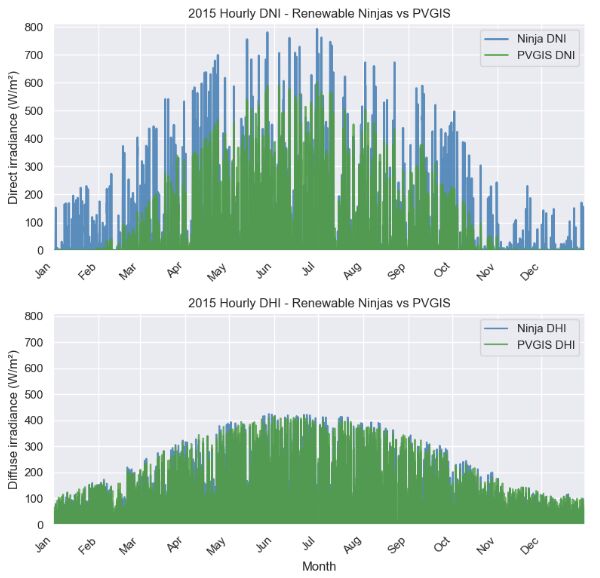The light or irradiance powering your solar farm is the basis of your project return. And the modelling you rely on splits irradiance into direct and diffuse light: a necessary but gross simplification. But it’s generally underappreciated just how much this key source of error ripples through and impacts solar returns.
Let’s examine a typical English site. As part of Corrie’s forensic work on solar yields, we validated irradiance outputs from two standard sources, Renewables Ninjas and PVGIS. Both use the same input satellite data but the different algorithms result in a 4.1% difference in total irradiance. But it’s not just about the total, the timing and composition also vary substantially. PVGIS, for instance, shows a bias towards higher irradiance in the mornings and evenings, particularly in winter. There are also stark differences in the direct versus diffuse light (figure).
Why Should I Care?
These aren’t minor discrepancies. Errors in energy estimation compound and significantly affect economics, impacting everything from the optimal array orientation (e.g., east-west vs. south-facing) and row spacing to installed capacity and BESS charging strategies. If your irradiance is wrong, this affects the Performance Ratio you negotiate with your EPC. Ask yourself: do you have the right irradiance data? What models are being used? Quantify the uncertainty in your financial models.
Predicting irradiance becomes even more critical when considering advanced technologies like solar trackers, which is why Corrie has accurate and validated approaches to irradiance uncertainty. This is precisely where Corrie’s extensive research and rigorous design methodology stands out. When evaluating a new technology, it’s vital to ensure it’s underpinned by the kind of in-depth research and design that Corrie has demonstrated. Without it, you can’t be truly confident where the errors lie.
